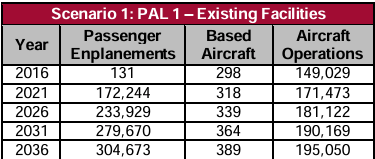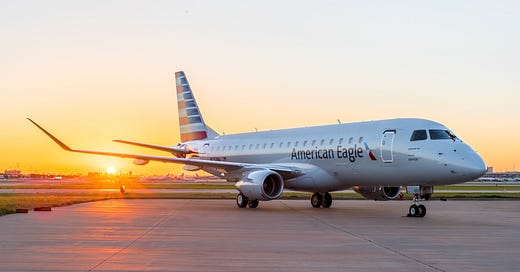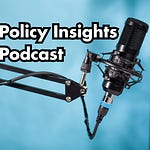
SAN DIEGO — A San Diego County Superior Court judge denied a motion for a preliminary injunction to stop service from American Airlines at McClellan-Palomar Airport on Friday.
Citizens for a Friendly Airport filed the lawsuit on Jan. 27 to stop the lease agreement between the county and American Airlines, which the Board of Supervisors approved in early January. The judge, Gregory Pollack, was unmoved by CF4A’s arguments and said the county and American Airlines would suffer “irreparable harm” since contracts have been signed, jobs and tickets sold, and a negative impact financial impact would be suffered by the county of more than $600,000, which American Airlines will pay to use McClellan-Palomar Airport.
American Airlines started service on Feb. 13 with two daily flights to Phoenix.
American Airlines attorney Jack Yeh argued CF4A completely changed the scope of the lawsuit from January, saying the injunction now wanted to cease all commercial operations compared to its initial complaint under the California Environmental Quality Act (CEQA). Yeh said the Superior Court was the wrong venue, CF4A provided no evidence of harm and said the organization waited too long and should have taken up the issue during its first lawsuit in 2018.
Yeh also said the plaintiffs had plenty of notice regarding the county’s plans, which included the 2018 lawsuit (settled in 2021), along with the Master Plan Update, which called for commercial service, and the announcement of American Airlines’ service in July, yet did nothing.
“Their position now is they want a complete ban on commercial service,” he told Pollack. “This is the first time they’ve said this. They’ve waived that argument. From an irreparable harm standard, the plaintiffs haven’t produced a single piece of evidence.”
CF4A’s attorney Corey Briggs argued the deal between the county and the county’s deal with American Airlines also violated Conditional Use Permit 172 between the city of Carlsbad and the county. The CUP was issued in 1980 and the attorneys and Pollack argued about its true intention — whether the city and county agreed about commercial service — for several minutes.
Pollack, though, said it’s unlikely the court would ascertain the intention since it’s likely all the people involved in the CUP from 1980 are dead.
Pollack appeared on the fence about the CUP, although he said if the case goes to trial, the plaintiffs may have an argument regarding the intended use. However, he also said the county engaged in commercial service from 1991-2015, while the county attorney noted there was also commercial service in 2017 (Cal Jet by Elite Airways serviced for one year followed by California Pacific Airlines from late 2018 to early 2019).
Yeh said there was no harm from those previous operations or since and didn’t seek a restraining order for the 2021 Master Plan Update for against the operations from American Airlines. The company also argued the previous lawsuit from 2018 challenged the airport’s physical footprint being expanded, while Pollack noted the airport didn’t expand to support American Airlines.

Briggs also argued the airport is designated a B-II facility using C-III aircraft and violates the CUP and standards of the airport. Yeh, though, said the Federal Aviation Administration allows for such crossovers and, again, noted those complaints should be taken to hearing with the FAA.
“This is a basic aviation general transport airport,” Briggs said. “The county, for the longest time, recognized the only flights would be by non-commercial transport.”
Briggs said another issue isn’t whether the FAA would allow a C-III aircraft but whether CUP 172 allows commercial service. He said the CUP allows for basic aviation general transport when it was issued in 1980.
The county, Briggs said, knew the only flights allowable were small and private planes and delivering service. Briggs said the issue isn’t about FAA regulations because his client isn’t challenging the land use decision, while the county said it is about the FAA regulations, and Briggs’ interpretation is incorrect.
“There’s clearly ambiguity,” Pollack said of the CUP dispute. “The reasonable thing to do would be to see how that airport was used. It’s clear between 1991 to 2015 it was used for commercial flights.”
Yeh, meanwhile, said the FAA has specifically ruled C-III planes can operate from a B-II facility. In addition, the county argued the CUP between the city and county is evidence both parties understood the airport would be allowed to operate commercial flights.
“The time and place for Mr. Briggs to have made this argument was during the 2021 Master Plan Update when all of these issues were before the county,” Yeh argued. “They didn’t object. They didn’t file a lawsuit. That went unchallenged.”
He said CF4A has no merits for their case with no evidence or law behind the argument based on a misreading of federal regulations. Also, when the master plan was approved, it specifically identified commercial flights as part of the airport’s future operations.
Yeh said CF4A and Briggs have had since 2021 to gather evidence and have yet to produce anything of relevance, just arguments, to compel a court to stop the agreement. American Airlines said perhaps the plaintiffs were too confident in their case.
In addition, if commercial operations were to stop, it could jeopardize federal funding the airport and the county’s airport system, the county stated. In January, county staff detailed how the FAA could pull its $5 million annual funding of eight airports, along with recouping more than $120 million in previous funding as FAA funding requires commercial service.
“The Master Plan Update identifies the future role of the Airport to include supporting local businesses, accommodating corporate users, providing regional commercial airline service, serving private recreational fliers and enhancing public safety,” the plan states on page 13. “These roles are all considered in planning future airport development.”
The plan also details baseline forecasts for commercial service and enplanements, along with accommodating general aviation, corporate operations and “re-established scheduled commercial service.”

Another issue was the financial impacts of the agreement and the injunction, Pollack said. He said if he granted the injunction, CF4A must pay a bond to temporarily cover the financial losses until a final resolution is decided.
Briggs argued the bond should be nominal at $150,000 or lower, while Pollack said it would likely be between $600,000 to $1 million and rejected the notion the bond should be nominal. Pollack asked Briggs if his clients could pay $150,000, which he said no.
Pollack said when looking at the balance of hardships, “it’s not even a close call” as CF4A has not satisfied it at all. He said the motion isn’t to maintain the status quo, but rather “dramatically” disrupt the status quo.
Briggs, though, said there one can’t draw an inference American Airlines is profiting off its service, whether flights are full or anything about the operations. He said American Airlines has not revealed those elements and the only financial report is from the county’s staff report approved by the Board of Supervisors.
Pollack, though, asked if the service wasn’t profitable, why would American Airlines hire an attorney to fight this lawsuit.
“We don’t think the merits are close,” Briggs said. “When the merits aren’t close we don’t have to show as much on the hardships. It’s a sliding scale.”
Finally, Pollack questioned why the city of Carlsbad wasn’t a party to the hearing since they have “skin in the game” and the city’s position. He said he didn’t know why the city wasn’t involved in the case as an intervener.
The city has not formally joined the case, although the City Council said it would discuss the matter. For the past two years, the city has approved several actions against pilots, updated city codes and zoning ordinances and several council members have stated they have concerns over the American Airlines contract.
A city spokesperson said Carlsbad has no pending litigation against the county or American Airlines. According to court records, attorney Edward Schexnayder of Shute, Mihaly & Weinberger LLP had an ex parte hearing scheduled on March 25 as a non-party for the city of Carlsbad. The hearing was canceled.
When asked about the San Francisco-based attorney and law firm and any connections to Carlsbad, the city did not respond and turned the media request into a public records filing, which was denied by City Attorney Cindie McMahon on March 24.
Regardless, Briggs said the city has been “asleep at the wheel,” noting CF4A sued the city in 2019. The county said if the argument pivots to whether Carlsbad should be involved, then the plaintiffs should sue Carlsbad to force the city into action.
The case has been scheduled for further hearings in November.
Follow North County Pipeline on Instagram, Facebook, X and Reddit. Send story ideas and tips to ncpipeline760@gmail.com.
Correction: The primary attorney was Jack Yeh of American Airlines, not county counsel. I regret the error.















Share this post